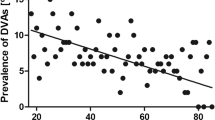Abstract
Developmental venous variations (DVVs) are anatomic variations of normal transmedullary veins which are often discovered incidentally. Although they are accepted as benign compensatory venous drainage systems, they may become symptomatic or clinically significant due to flow-related causes. The fragile venous drainage systems increase vulnerability to in–out flow alterations. Increased inflow or decreased outflow causes rise in venous pressure, which may subsequently produce ischemic symptoms. Obstruction or stenosis of the collector vein is the most common cause of decreased outflow of a DVV. However, in the absence of collecting vein stenosis, venous hypertension may still exist due to volume overload. In case of multiple DVVs with single combined drainage pathway, functional outflow restriction may occur due to diminished capability of the vessel to adapt to pressure changes. In this report, we present a case with bilateral thalamic DVVs, which cause parenchymal amorphous calcification and drain into the left internal cerebral vein. A review of the literature on DVVs with outflow restriction including pathophysiological mechanisms is also discussed.




Similar content being viewed by others
References
Agazzi S, Regli L, Uske A, Maeder P, de Tribolet N (2001) Developmental venous anomaly with an arteriovenous shunt and a thrombotic complication. Case report. J Neurosurg 94(3):533–537
Andeweg J (1999) Consequences of the anatomy of deep venous outflow from the brain. Neuroradiology 41(4):233–241
Dehkharghani S, Dillon WP, Bryant SO, Fischbein NJ (2010) Unilateral calcification of the caudate and putamen: association with underlying developmental venous anomaly. AJNR Am J Neuroradiol 31:1848–1852
Dudeck O, van Velthoven V, Schumacher M, Klisch J (2004) Development of a complex dural arteriovenous fistula next to a cerebellar developmental venous anomaly after resection of a brainstem cavernoma. Case report and review of the literature. J Neurosurg 100(2):335–339
Enslin JMN, Lefeuvre D, Taylor A (2013) Developmental venous anomaly with contralateral impaired venous drainage in a 17-year-old male. Interv Neuroradiol 19:67–72
Forsting M, Wanke I (2006) Developmental venous anomalies. In: Forsting M (ed) Intracranial vascular malformations and aneurysms. Springer, New York, pp 1–13
Geibprasert S, Krings T, Pereira V, Lasjaunias P (2007) Infantile dural arteriovenous shunt draining into a developmental venous anomaly. Interv Neuroradiol 13(1):67–74
Hacker DA, Latchaw RE, Chou SN, Gold LH (1981) Case report. Bilateral cerebellar venous angioma. J Comput Assist Tomogr 5(3):424–426
Kuncz A, Vörös E, Varadi P, Bodosi M (2001) Venous cerebral infarction due to simultaneous occurrence of dural arteriovenous fistula and developmental venous anomaly. Acta Neurochir (Wien) 143(11):1183–1184
Lasjaunias P, Burrows P, Planet C (1986) Developmental venous anomalies (DVA): the so-called venous angioma. Neurosurg Rev 9:233–242
Lee C, Pennington MA, Kenney CM (1996) MR evaluation of developmental venous anomalies: medullary venous anatomy of venous angiomas. AJNR Am J Neuroradiol 17:61–70
Linscott LL, Leach JL, Zhang B, Jones BV (2014) Brain Parenchymal signal abnormalities associated with developmental venous anomalies in children and young adults. AJNR Am J Neuroradiol 35:1600–1607
Nussbaum ES, Defillo A, Nussbaum L (2013) Developmental venous anomaly associated with hemi-Parkinson’s syndrome. Cureus 5(1):e80. doi:10.7759/cureus.80
Okudera T, Huang YP, Fukusumi A et al (1999) Micro-angiographical studies of the medullary venous system of the cerebral hemisphere. Neuropathology 19:93–111
Pearl M, Gregg L, Gandhi D (2011) Cerebral venous development in relation to developmental venous anomalies and vein of galen aneurysmal malformation. Semin Ultrasound CT MRI 32:252–263
Pereira VM, Geibprasert S, Krings T et al (2008) Pathomechanisms of symptomatic developmental venous anomalies. Stroke 39:3201–3215
Raybaud C (2010) Normal and abnormal embryology and development of the intracranial vascular system. Neurosurg Clin N Am 21:399–426
Saito Y, Kobayashi N (1981) Cerebral venous angiomas: clinical evaluation and possible etiology. Radiology 139:87–94
San Millán Ruíz D, Delavelle J, Yilmaz H et al (2007) Parenchymal abnormalities associated with developmental venous anomalies. Neuroradiology 49:987–995
San Millán Ruíz D, Yilmaz H, Gailloud P (2009) Cerebral developmental venous anomalies: current concepts. Ann Neurol 66:271–283
Santucci GM, Leach JL, Ying J, Leach SD, Tomsick TA (2008) Brain parenchymal signal abnormalities associated with developmental venous anomalies: detailed MR imaging assessment. AJNR Am J Neuroradiol 29:1317–1323
Striano S, Nocerino C, Striano P et al (2000) Venous angiomas and epilepsy. Neurol Sci 21:151–155
Truwit CL (1992) Venous angioma of the brain: history, significance, and imaging findings. AJR Am J Roentgenol 159:1299–1307
Uchino A, Hasuo K, Matsumo S, Masuda K (1995) Double cerebral venous angiomas: MRI. Neuroradiology 37:25–28
Uddin MA, Hag TU, Rafique MZ (2006) Cerebral venous system anatomy. J Pak Med Assoc 56(11):516–519
Valavanis A, Wellauer J, Yasargil MG (1983) The radiological diagnosis of cerebral venous angioma: cerebral angiography and computed tomography. Neuroradiology 24:193–199
Vattoth S, Purkayastha S, Jayadevan ER, Gupta AK (2005) Bilateral cerebral venous angioma associated with varices: a case report and review of the literature. AJNR Am J Neuroradiol 26:2320–2322
Author information
Authors and Affiliations
Corresponding author
Ethics declarations
Conflict of interest
The authors declare that they have no conflict of interest.
Rights and permissions
About this article
Cite this article
Sahin, H., Pekcevik, Y. Bilateral thalamic developmental venous variations (DVVs) draining into same internal cerebral vein: a case report and review with emphasis on DVVs with outflow restriction. Surg Radiol Anat 38, 711–716 (2016). https://doi.org/10.1007/s00276-016-1619-8
Received:
Accepted:
Published:
Issue Date:
DOI: https://doi.org/10.1007/s00276-016-1619-8




